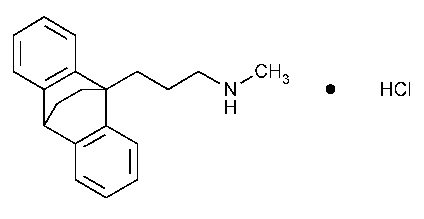Maprotiline Hydrochloride
9,10-Ethanoanthracene-9(10H)-propanamine,N-methyl-,hydrochloride.
N-Methyl-9,10-ethanoanthracene-9(10H)-propylamine hydrochloride [10347-81-6].
»Maprotiline Hydrochloride contains not less than 99.0percent and not more than 101.0percent of the labeled amount of C20H23N·HCl,calculated on the dried basis.
Packaging and storage—
Preserve in tight containers.
Identification—
A:
Infrared Absorption á197Kñ.
B:
Ultraviolet Absorption á197Uñ—
Solution:
100µg per mL.
Medium:
methanol.
Absorptivities at 266nm and 272nm,calculated on the dried basis,do not differ by more than 3.0%.
C:
Asolution (1in 200)responds to the tests for Chloride á191ñ,when tested as specified for alkaloidal hydrochlorides.
Loss on drying á731ñ—
Dry it in vacuum at 80 to constant weight:it loses not more than 1.0%of its weight.
to constant weight:it loses not more than 1.0%of its weight.
Residue on ignition á281ñ:
not more than 0.1%.
Heavy metals,Method IIá231ñ:
0.001%.
Chromatographic purity—
Standard solutions—
Dissolve USP Maprotiline Hydrochloride RSin methanol,and mix to obtain a stock standard solution having a known concentration of 20mg per mL.Dilute quantitatively with methanol to obtain Standard solutionhaving a known concentration of 0.10mg per mL.Dilute quantitatively with methanol to obtain Standard solutions,designated below by letter,having the following compositions:
| Standardsolution | Dilution | Concentration
(µg RS per mL) |
Percentage (%,
for comparison with test specimen) |
| A | (undiluted) | 100 | 0.5 |
| B | (4in 5) | 80 | 0.4 |
| C | (3in 5) | 60 | 0.3 |
| D | (2in 5) | 40 | 0.2 |
| E | (1in 5) | 20 | 0.1 |
Test solution—
Dissolve an accurately weighed quantity of Maprotiline Hydrochloride in methanol to obtain a solution containing 20mg per mL.
Procedure—
In a suitable chromatographic chamber (see Chromatography á621ñ),place a volume of a solvent system consisting of a mixture of secondary butyl alcohol,ethyl acetate,and 2Nammonium hydroxide (6:3:1)sufficient to develop a chromatogram.Place a beaker containing 25mLof ammonium hydroxide in the bottom of the chamber,and allow it to equilibrate for 1hour.Apply 5-µLportions of the Test solution,the stock standard solution,and each of the Standard solutionsto a suitable thin-layer chromatographic plate coated with a 0.25-mm layer of chromatographic silica gel that has been pre-washed with chloroform by allowing chloroform to move the full length of the plate,and dried at 100 for 30minutes,and allow the spots to dry.Develop the chromatograms until the solvent front has moved about three-fourths of the length of the plate,remove the plate from the developing chamber,mark the solvent front,and allow the solvent to evaporate.Expose the plate to hydrogen chloride vapor for 30minutes,expose it to a high-intensity UVlight irradiator (1000to 1600watts)[Caution—UVirradiators emit UVradiation that is harmful to eyes and skin.
]until the spot in the chromatogram of Standard solution Eis clearly visible,and compare the chromatograms under long-wavelength UVlight:the RFvalue of the principal spot obtained from the Test solutioncorresponds to that obtained from the stock standard solution;and the sum of the intensities of all secondary spots obtained from the Test solution,compared with those of the principal spots obtained from the Standard solutions,corresponds to not more than 1.0%.
for 30minutes,and allow the spots to dry.Develop the chromatograms until the solvent front has moved about three-fourths of the length of the plate,remove the plate from the developing chamber,mark the solvent front,and allow the solvent to evaporate.Expose the plate to hydrogen chloride vapor for 30minutes,expose it to a high-intensity UVlight irradiator (1000to 1600watts)[Caution—UVirradiators emit UVradiation that is harmful to eyes and skin.
]until the spot in the chromatogram of Standard solution Eis clearly visible,and compare the chromatograms under long-wavelength UVlight:the RFvalue of the principal spot obtained from the Test solutioncorresponds to that obtained from the stock standard solution;and the sum of the intensities of all secondary spots obtained from the Test solution,compared with those of the principal spots obtained from the Standard solutions,corresponds to not more than 1.0%.
Organic volatile impurities,Method Vá467ñ:
meets the requirements.
Solvent—
Use dimethyl sulfoxide.
Assay—
Dissolve about 600mg of Maprotiline Hydrochloride,accurately weighed,in 25mLof mercuric acetate TS,and titrate with 0.1Nperchloric acid VS,determining the endpoint potentiometrically,using a glass electrode and a calomel electrode containing saturated lithium chloride in glacial acetic acid (see Titrimetry á541ñ).Perform a blank determination,and make any necessary correction.Each mLof 0.1Nperchloric acid is equivalent to 31.39mg of C20H23N·HCl.
Auxiliary Information—
Staff Liaison:Salvador C.Salado,M.S.,Scientist and Latin American Liaison
Expert Committee:(PA3)Pharmaceutical Analysis 3
USP28–NF23Page 1184
Phone Number:1-301-816-8165
